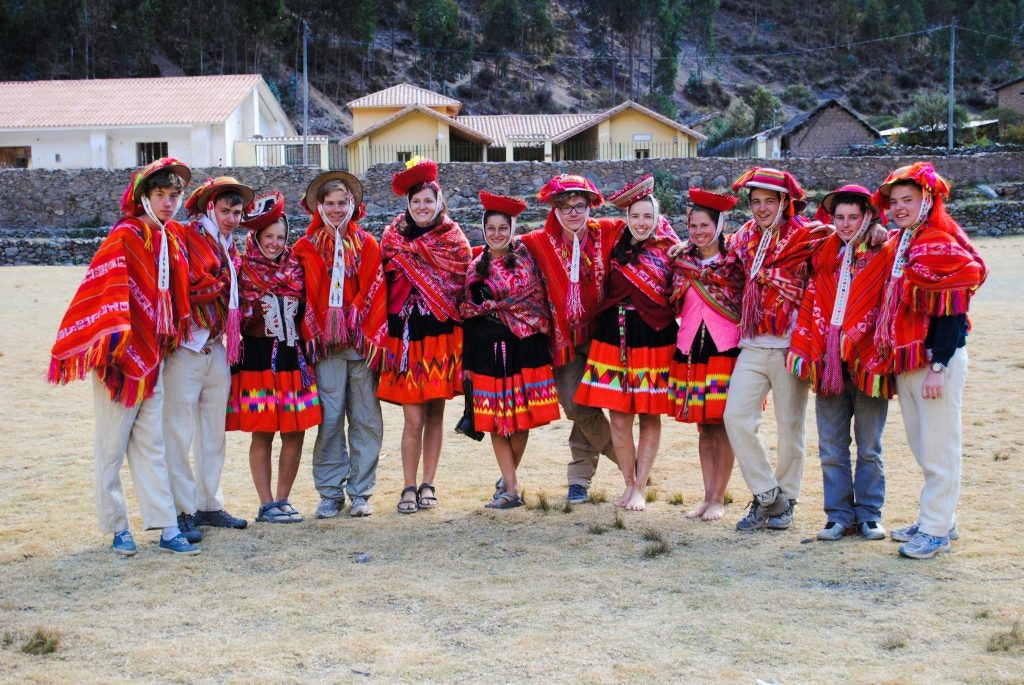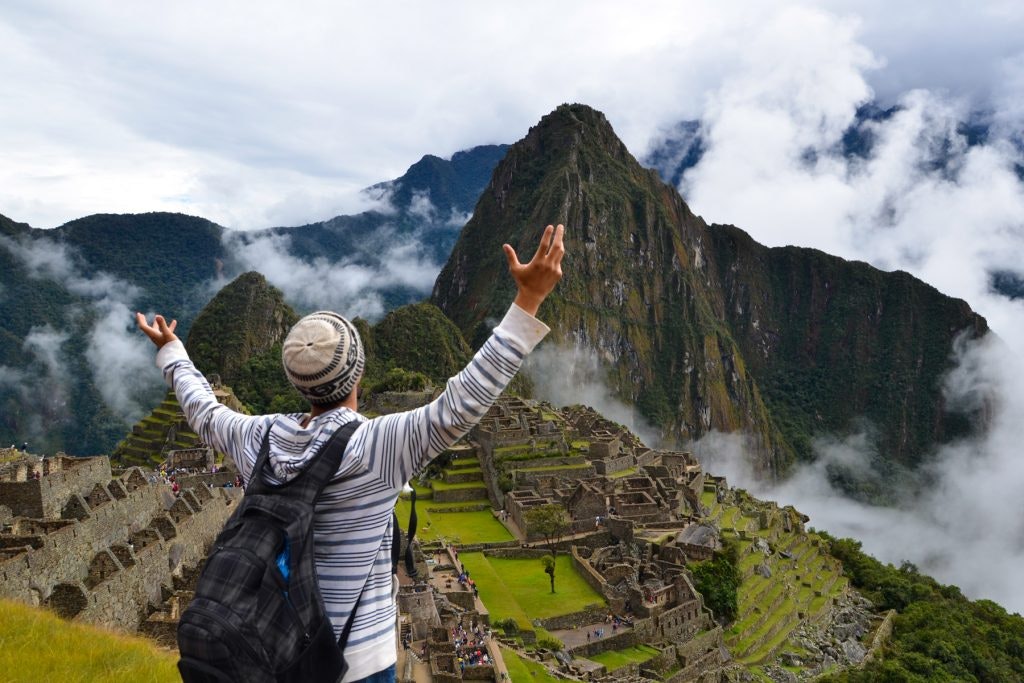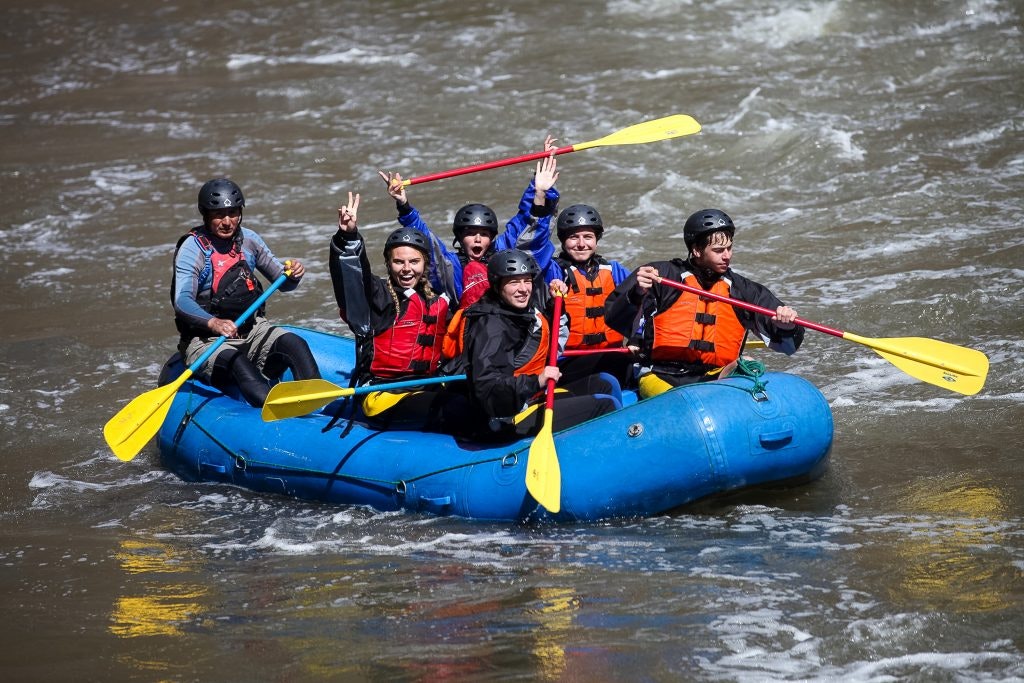4. What’s the altitude of the Sacred Valley in Peru?
The Sacred Valley is at a lower elevation than Cusco city, averaging 8,000–9,000 feet above sea level.
This altitude can pose challenges for some. For a trip to the Sacred Valley, prepare with proper equipment:
- Sun protection: Hats, sunscreen, and sunglasses to combat strong UV rays at high altitudes.
- Waterproof jacket: Essential during the rainy season (October–April).
- Water: Drink plenty of water to stay acclimated.
![]()
Rustic Pathways students taking in the view of the Sacred Valley of Peru.
5. Why is it called the Sacred Valley?
The name Sacred Valley originates from its significance to the Inca Empire and its spiritual alignment with the Urubamba River (Willkamayu in Quechua, meaning “Sacred River”).
The valley’s fertile land supported agricultural production, and its alignment with the Milky Way held spiritual significance for the Incas. The valley was a central part of the Inca heartland, revered as a gift from Mother Earth (Pachamama).
6. Who lived in the Sacred Valley?
The Inca Empire dominated the Sacred Valley during its peak, leaving behind remarkable Inca ruins, including agricultural terraces, ceremonial sites, and fortresses.
Before the Incas, other civilizations thrived here, including the Chanapata, Killke, and Qotacalla. These cultures contributed to the Inca civilization’s architectural and agricultural achievements.
Today, Quechua-speaking communities preserve many of these ancient traditions, weaving the valley’s history into daily life.
7. Why do local indigenous people use bright colors in their textiles?
The vibrant textiles of the Sacred Valley reflect traditions that date back to Inca times. The colors are derived from natural dyes made from plants, insects, and minerals.
Each color holds meaning:
- Red: Associated with blood and fertility.
- Purple: Linked to the founding mother of the Incas.
- Green: Symbolizes crops
- Black: Connected to time and authority
Visitors can see these textiles being created and sold at markets or during cultural tours, which provide the perfect opportunity for visitors to have interactions with local people.

8. What foods are popular in the Sacred Valley?
The Sacred Valley offers an array of traditional dishes rooted in Inca history:
- Cuy (guinea pig): A delicacy dating back 5,000 years.
- Corn (maize): Peru grows over 50 varieties, many native to the valley floor.
- Potatoes: With over 3,000 types, they’re a staple of the region.
9. Why are there so many alpacas in the Sacred Valley?
There are so many alpacas in the Sacred Valley due to its high-altitude environment. In fact, Peru is home to 70% of the world’s alpaca population. These animals provide:
- Wool, used in textiles and considered the “fiber of the gods.”
- Manure, which serves as a natural fertilizer for crops.
- Meat, a traditional protein source for local communities.
![alpacas in Peru]()
10. What can you see in the Sacred Valley?
The Sacred Valley is home to numerous important archaeological sites, including:
- Pisac ruins: Known for their terraces and ceremonial baths.
- Ollantaytambo ruins: Featuring a towering Inca fortress.
- Moray ruins: Believed to be an agricultural testing site.
- Maras salt mines: Still producing salt as they have since pre-Inca times.
![Campsite in the mountains of the Sacred Valley]()
Camp with us under the stars in the Sacred Valley.
11. What can you expect on a Sacred Valley tour?
A Sacred Valley tour is the perfect way to explore this historic region. These tours typically feature visits to the Pisac ruins, Ollantaytambo ruins, and the terraced agricultural masterpiece at Moray.
For more details on what you can experience in the Sacred Valley, check out our Sacred Valley Service program or our Spring to the Sacred Valley program.
![]()
Rustic Pathways Program Leader Nancy Trujillo, who has traveled to many nations, says the views aren’t limited to the daytime. The nights are also particularly memorable.
12. What adventure activities are there in the Sacred Valley?
The Sacred Valley is a paradise for outdoor enthusiasts, offering:
- Hiking trails, including the Inca Trail and Salkantay Trek.
- Ziplining: Experience the valley from above.
- Water sports: Kayaking, paddleboarding, and whitewater rafting.
- Rock climbing and bungee jumping for thrill-seekers.
- Horseback riding and ATV tours for more leisurely exploration.

Credit: Rustic PathwaysFor a unique experience, stay at the Skylodge Adventure Suites, transparent pods suspended on a cliffside.







